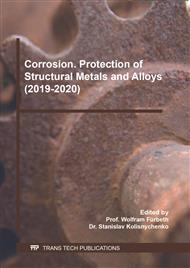[1]
L. Fan, H.Y. Chen, Y.H. Dong, L.H. Dong, Y.S. Yin, Wear and corrosion resistance of laser cladded Fe-based composite coatings on AISI 4130 steel, Int. J. Miner. Metall. Mater. 25 (2018) 716-728.
DOI: 10.1007/s12613-018-1619-2
Google Scholar
[2]
S. S. Liu, H. Y. Chen, X. Zhao, L. Fan, X. M. Guo, Y.S. Yin, Corrosion behavior of Ni-based coating containing spherical tungsten carbides in hydrochloric acid solution, J. Iron Steel Res. Int. 26 (2019) 191-199.
DOI: 10.1007/s42243-019-00240-y
Google Scholar
[3]
N. Hutasoit, V. Luzin, A. Blicblau, W. Yan, M. Brandt, and R. Cottam, Fatigue life of laser clad hardfacing alloys on AISI 4130 steel under rotary bending fatigue test, Int. J. Fatigue 72 (2015) 42-52.
DOI: 10.1016/j.ijfatigue.2014.11.001
Google Scholar
[4]
J. Pereira, J. Zambrano, M. Licausi, and V. Amigó, Tribology and high temperature friction wear behavior of MCrAlY laser cladding coatings on stainless steel, Wear, 330-331 (2015) 280-287.
DOI: 10.1016/j.wear.2015.01.048
Google Scholar
[5]
S. Hochstrasser, Y. Mueller, C. Latkoczy, S. Virtanen, P. Schmutz, Analytical characterization of the corrosion mechanisms of WC-Co by electrochemical methods and inductively coupled plasma mass spectroscopy, Corros. Sci. 49 (2007) 2002-2020.
DOI: 10.1016/j.corsci.2006.08.022
Google Scholar
[6]
X.R. Zhu, G.Q. Huang, L.Y. Lin, Long term corrosion characteristics of metallic materials in marine environments. British Corros. J. 43(2008) 328-334.
Google Scholar
[7]
P.R. Reinaldo, A.S.C.M. D'Oliveira, NiCrSiB coatings deposited by plasma transferred arc on different steel substrates, J. Mater. Eng. Perform. 22(2013) 590-597.
DOI: 10.1007/s11665-012-0271-7
Google Scholar
[8]
G.Q. Chen, X.S. Fu, Y.H. Wei, S Li, W.L. Zhou, Microstructure and wear properties of nickel-based surfacing deposited by plasma transferred arc welding, Surf. Coat. Technol. 228 (2013) 276-282.
DOI: 10.1016/j.surfcoat.2012.05.125
Google Scholar
[9]
S. Katakam, V. Kumar, S. Santhanakrishnan, R. Rajamure, P. Samimi, and N.B. Dahotre, Laser assisted Fe-based bulk amorphous coating: Thermal effects and corrosion, J. Alloys Compd., 604 (2014) 266-272.
DOI: 10.1016/j.jallcom.2014.03.137
Google Scholar
[10]
A. Davoodi, M. Pakshir, M. Babaiee, and G.R. Ebrahimi, A comparative H2S corrosion study of 304L and 316L stainless steels in acidic media, Corros. Sci. 53 (2011) 399-408.
DOI: 10.1016/j.corsci.2010.09.050
Google Scholar
[11]
Y.L. Zhou, J. Chen, Y. Xu, and Z.Y. Liu, Effects of Cr, Ni and Cu on the corrosion behavior of low carbon microalloying steel in a Cl–containing environment, J. Mater. Sci. Technol. 29 (2013), 168-174.
DOI: 10.1016/j.jmst.2012.12.013
Google Scholar
[12]
M.W. Tan, E. Akiyama, H. Habazaki, A. Kawashima, K. Asami, and K. Hashimoto, The role of chromium and molybdenum in passivation of amorphous Fe-Cr-Mo-P-C alloys in deaerated 1 M HCl, Corros. Sci. 38 (1996) 2137-2151.
DOI: 10.1016/s0010-938x(96)00071-6
Google Scholar
[13]
E.D. Mor, A.M. Beccaria, Effects of hydrostatic pressure on the corrosion of copper in sea water, British Corros. J.13 (2013) 142-146.
DOI: 10.1179/000705978798276267
Google Scholar
[14]
W. Fredriksson, S. Malmgren, Full depth profile of passive films on 316L stainless steel based on high resolution HAXPES in combination with ARXPS, Appl. Surf. Sci. 258 (2012) 5790-5797.
DOI: 10.1016/j.apsusc.2012.02.099
Google Scholar
[15]
M.D.C Belo, N.E. Hakiki, M.G.S. Ferreira, Semiconducting properties of passive films formed on nickel-base alloys type Alloy 600: influence of the alloying elements, Electrochim. Acta 44 (1999) 2473-2481.
DOI: 10.1016/s0013-4686(98)00372-7
Google Scholar
[16]
J.W. Schultze, M.M. Lohrengel, Stability, reactivity and breakdown of passive films: Problem of recent and future research, Electrochi Acta 45 (2000) 2499-2513.
DOI: 10.1016/s0013-4686(00)00347-9
Google Scholar



